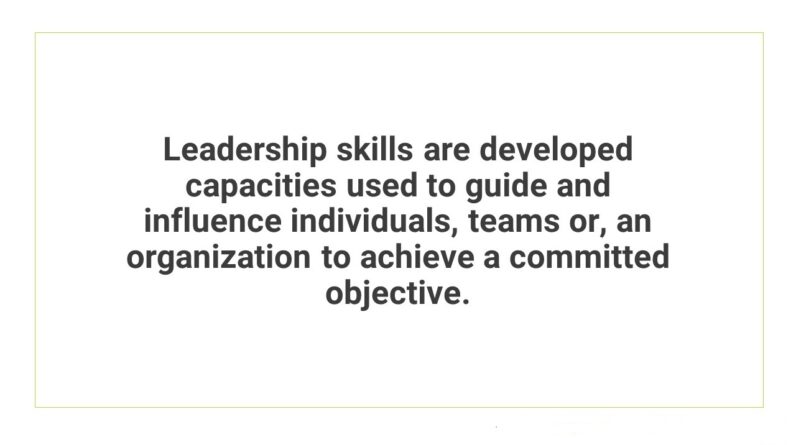 What Is Leadership? Quite simply, it’s the ability to influence others to act in a certain way. According to John C. Maxwell, author of Developing the Leader Within You, leadership is a process of social influence. Leadership requires planning, controlling, listening, and influencing others. Here are some ways to develop this ability. You can start developing it today. To achieve it, make the decision to develop it.
What Is Leadership? Quite simply, it’s the ability to influence others to act in a certain way. According to John C. Maxwell, author of Developing the Leader Within You, leadership is a process of social influence. Leadership requires planning, controlling, listening, and influencing others. Here are some ways to develop this ability. You can start developing it today. To achieve it, make the decision to develop it.
Leadership is a process of social influence
Leaders have many styles and abilities, but in general, they have the same goal: to motivate and engage others. While a boss can use coercive power and positional authority to motivate his or her people, the leader can inspire by saying and doing things that inspire others. A leader can inspire a team to achieve its goals through positive reinforcement and a focus on the group’s collective good. A leader must have the capability of instilling positive attitudes, which in turn will entice others to do the same.
The conventional view of leadership focuses on the leader’s capacity to affect others, but it neglects the social context, which can moderate the contributions of a leader. The concept of leadership has been challenged by Noam Chomsky, who asserts that people abrogate their own responsibility to think and act in their own interests. While the conventional view may satisfy people who want to be told what to do, it fails to acknowledge the complexity of societal circumstances and the potential for conflict.
While leadership can maximize individual efforts, it cannot be done without the assistance of other people. Some famous leaders, such as Michael Jordan, exhibited both a controversial and effective leadership style. In addition to being an exemplary leader, Jordan was also a controversial figure who led the young Wizards to championships. Leadership can maximize the efforts of others, as it can only maximize them if others follow the leader. Whether you want to lead an organization or a team, you can use leadership to achieve your goals.
Leadership involves planning
Planning is one of the fundamental skills of a leader. In addition to directing people, it involves making sure that resources are available and hazards are mitigated. Creating a plan before you start working on a project is essential to the health and safety of your team. It is also important to think about the future when planning, such as obtaining permits and resources needed for your project. It is essential to keep all employees informed of the plan’s progress and to evaluate its effectiveness before it is implemented.
Leadership involves listening
Effective communication is key to leading a team, and listening to your employees is one of the most effective ways to do this. Active listening involves identifying key points of their comments, asking questions to ensure that you understand the issue, and being involved while you are communicating. This builds healthy relationships and fosters a productive environment. Listening to your employees can be a powerful tool to help improve your company’s productivity and profitability. Read on for some tips on how to effectively listen to your team members.
Effective listening requires putting away devices such as your cell phone and checking your email while you listen. It requires a high degree of concentration and a willingness to put aside personal agendas. To listen effectively, you must recognize your own biases and filters and be able to identify the emotions that may be conveyed. Once you have mastered these techniques, you can use them to improve communication and collaboration. You can also improve your emotional intelligence by learning to recognize when people are trying to communicate a difficult point.
Active listening builds mutual understanding. This skill requires you to focus fully on the other person without interrupting them. By doing so, you build a bond and respect with them. Moreover, active listening helps you understand their point of view, which is often essential to getting to know their ideas. As a manager, you must be able to match spoken words with unspoken actions. You will have a better chance of understanding what’s really bothering your employees and creating the best possible solution.
It involves making the right decision at the right time
A great leader knows how to balance reason and emotion to make good decisions that have a positive impact on themselves, their employees, customers, stakeholders, and their organizations. Making the right decision at the right time requires change, anxiety, and stress, and it requires overcoming unfavourable reactions from others. Here are some tips to make a good decision at the right time. Let’s look at each one individually.
Good decisions are often based on empathy. Leaders should be willing to risk their reputations to make the best decision possible. Knowledge, intuition, and a willingness to take risk are all important in making the right decision. These qualities can be acquired over time through experience, but a good decision requires a good deal of skill and insight. And while this is difficult, it is essential for any leader to constantly strive for improvement.
Leadership involves taking risks
Taking risks is a critical element of leadership. Risk taking is the action of performing a task despite a lack of certainty or fear of failure. This risk-taking process requires courage, since we tend to be swayed by fears of failure or success. It also requires a willingness to make mistakes. To develop your risk-taking skills, follow these tips. These will help you be a more confident leader.
Employees need to know the benefits of taking risks before they’re comfortable taking them. In other words, employees need to be sure that their risk-taking decisions are connected to the organization’s goals and strategic objectives. This can be difficult if employees are uncertain about the benefits of taking risks. They may also be concerned that their actions will be interpreted as “kissing up to upper management.” However, it’s important to recognize the value of risk-taking in the workplace.
In order to achieve leadership success, a leader must have the courage to take calculated risks. To be a courageous leader, a leader must be willing to take risks in order to develop creativity, innovation, and change. As a result, the leader must be willing to face the risk of failure and embrace it as an opportunity for growth. If the leader can manage risk and failure without fear, he or she will become a more respected leader.
What Are The Types Of Leadership?
There are five main types of leadership. In this article, we’ll look at Transformational, Autocratic, Democratic, and Affiliative. If you’re wondering which kind you’re most likely to follow, read on! Listed below are the characteristics of each. The difference between these five styles of leadership is discussed, along with their strengths and weaknesses. Read on to learn about the types of leadership and how they differ in your organization.
Autocratic
While autocratic leadership styles may provide a company with a high rate of attrition, they can also lead to mental breakdowns in employees. Employees who work for an autocratic leader are unable to voice their ideas and aren’t allowed to consider feedback. This style of leadership also doesn’t give team members much opportunity to improve their soft skills. However, some businesses are finding that autocratic leadership can work very well in some situations.
When used in the right context, autocratic leadership styles don’t require open communication. This style of leadership is often necessary for a number of reasons. The leader should listen to input from others before making decisions. However, a leader should avoid creating an environment in which workers feel inferior. To achieve this, a leader should always establish trust in his or her employees and avoid giving feedback that makes employees feel inferior to him or her.
The key to implementing autocratic leadership style in your team is to recognize its positive and negative traits. While autocratic leaders are highly capable of inspiring their teams, they should also have the skills to effectively communicate with subordinates. Autocratic leaders must believe in their abilities and must be self-confident. While they may be able to make quick decisions, autocratic leadership can affect a team’s morale and creativity.
Although autocratic leadership styles don’t have a good reputation in today’s democratic work environment, they can have many positive aspects. For example, an autocratic leader may be passionate and highly motivated to see the organisation succeed. They may not always be able to listen to the opinions of their subordinates, but they are incredibly effective in some cases. The only real negative of autocratic leadership is the lack of participation from employees.
Transformational
As a leader, you have a responsibility to inspire your team to be their best selves. Transformative leaders model high standards and instill a mission mindset in their followers. These leaders serve as role models, modeling ethical behavior, enthusiasm for the company’s mission, and dedication to the team and work. Transformational leadership is all about improvement and achieving success. It’s not enough to set the agenda and expect your team to deliver. You have to empower your team members and inspire them to meet the goals you’ve set for them.
A transformational leader will listen to what their followers have to say. They’ll encourage constructive criticism and build relationships. They’ll be more likely to develop the talent and skills of their followers, which will benefit the organization as a whole. The best transformational leaders also promote psychological safety among their team members, which will foster innovation and creativity. A transformational leader is always preparing for the next change. So how do you become a transformational leader?
Leaders who practice transformational leadership know that marginal gains can lead to dramatic results. As such, they strive to make dramatic differences in small steps. Examples of transformational leaders include Satya Nadella, the CEO of Microsoft. Nadella took the company from irrelevance to dominance in less than five years. He’s been instrumental in transforming Microsoft’s culture. The benefits of transformational leadership are immense. However, transformational leaders should be aware of the potential pitfalls.
Despite the fact that both methods are effective, they do have their own advantages. Despite the differences in their methods, the two styles of leadership share the same aspiration: consistently getting employees to achieve goals. However, transactional leadership relies more on rewards and punishments, while transformational leadership focuses more on inspiring others to think of new ideas. They also encourage their employees to offer new ideas, which are often generated by the people who do the work.
While training is very effective when done right, it is often insufficient in cementing the desired cultural changes. Organizations should move beyond training as a knee-jerk reaction and find ways to embed transformational leadership principles in their company’s values and culture. You can also create your own transformational leadership program by incorporating the principles of transformational leadership into your own core values. The key to transformational leadership is to create a culture of change within your company.
Democratic
A good democratic leader listens to the views of all members of the team and considers them as valuable inputs. When a democratic leader consults with front-line workers, he or she is more likely to make decisions that benefit many. Such leaders also foster a climate of respect among team members, which increases collaboration and problem-solving. A democratic leader also helps avoid employee turnover. So, what makes a good democratic leader? Below are a few things to keep in mind.
Democracies have an important role to play in every organization. The members of a democratic organization are only as good as their leaders. If a leader is not trusted to guide decisions, he or she is likely to create negative outcomes. This is why training is such an important component of democratic leadership. Training allows members to develop their leadership skills and gain practice without fear of failure. This way, the democratic leader will be able to avoid the pitfalls of a centralized leadership style.
Another important benefit of democratic leadership is that it encourages employees to make smart decisions. Incorporating shared responsibilities into a team’s work will help employees develop valuable skills like critical thinking, self-esteem, and competence. The disadvantage of democratic leadership is that it requires a lot more time to make decisions, particularly when the team members are not all trained and experienced. As a result, a democratic leader needs to be patient and make sure that all ideas are vetted. Otherwise, the group may fail to produce any effective solutions.
While democratic leadership has many advantages, it is not appropriate for every organization. It may not be appropriate in all situations, but for many organizations, it can help them grow and succeed. It fosters open communication and allows team members to innovate and be more productive. If a democratic leader leads an organization to achieve success, the company will experience increased productivity and efficiency. It is a vital component of successful leadership. If a leader is able to cultivate a culture of open communication, it can help the business thrive during a crisis or during a growth phase.
Affiliative
As a manager, you should consider the advantages and disadvantages of affiliative leadership. This style of leadership encourages workers to use their creativity and risk failing rather than following orders. Affiliative leaders are also known for their openness and willingness to let bygones be bygones, even if they may not be the best at it. This style of leadership is often associated with poorly performing organisations. But it can also benefit your employees’ well-being.
Affiliative leaders are usually brought in to fix problems in a team. They encourage creativity by making employees feel important. They also avoid conflict resolution and look for opportunities to resolve differences in teams. Affiliative leaders have a reputation for fostering trust and encouraging employees to work together without fear of confrontation. And, they are great at motivating teams. If you want to learn how to be an affiliative leader, keep reading!
Affiliate leadership style is all about creating a happy team. Affiliative leaders lavish their employees with praise and encouragement, but don’t give too many instructions. This style of leadership allows team members to work together and innovate without constant supervision. And, because it fosters a sense of team togetherness, affiliate leaders are better able to handle difficult workplace situations. Affiliative leadership style has many advantages. You can use it to create a more positive work environment and a happier team.
Affiliative leaders are typically brought into a team after a stressful event, such as a merger or firing. Because of this, they must be ready for the emotional ups and downs of the team. Affiliative leaders are not authoritative in their discussions with employees. Instead, they try to keep the conversation positive, focusing on the positive aspects of the work. In addition, they take into account the feelings of their team members when discussing feedback.
Affiliative leaders do not dwell on the negatives of their team. Instead, they focus on the positives. Employees feel empowered to voice their opinions, which can lead to higher productivity. Affiliative leaders are also less likely to complain. Affiliative leaders encourage their team members to express their emotions in the workplace. These traits are highly valued by employees. They encourage employees to express their feelings, which helps them feel more confident and motivated.






